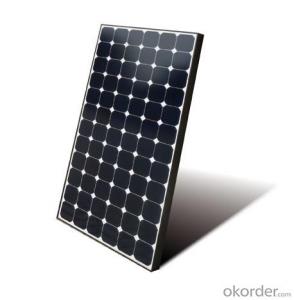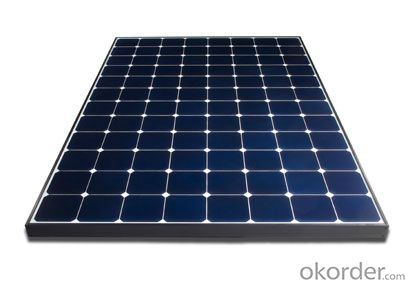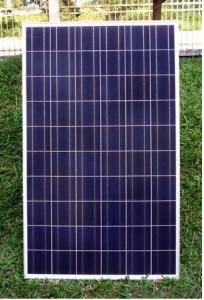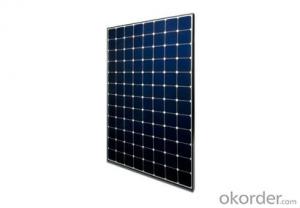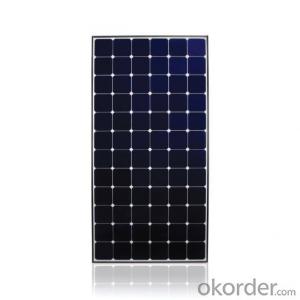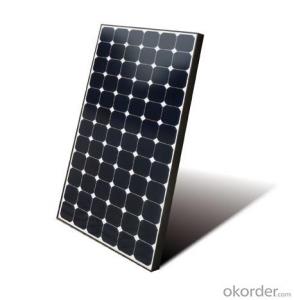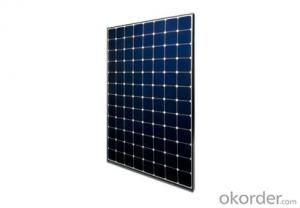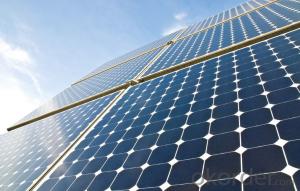Astro Solar Panels - Monocrystalline Solar Module 230W with Outstanding Quality and Price
- Loading Port:
- Shanghai
- Payment Terms:
- TT OR LC
- Min Order Qty:
- 100 watt
- Supply Capability:
- 10000 watt/month
OKorder Service Pledge
OKorder Financial Service
You Might Also Like
Specification
Monocrystalline Solar Module 230W with Outstanding Quality and Price
Production Description
solar cell (or a "photovoltaic" cell) is a device that converts photons from the sun (solar light) into electricity.
In general, a solar cell that includes both solar and nonsolar sources of light (such as photons from incandescent bulbs) is termed a photovoltaic cell.
a solar thermal collector supplies heat by absorbing sunlight, for the purpose of either direct heating or indirect electrical power generation from heat. A "photoelectrolytic cell" (photoelectrochemical cell), on the other hand, refers either to a type of photovoltaic cell (like that developed by Edmond Becquerel and modern dye-sensitized solar cells), or to a device that splits water directly into hydrogen and oxygen using only solar illumination.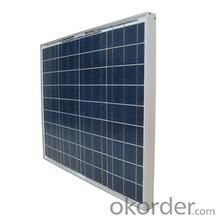
Application
remote area home system
earth orbiting satellites
consumer system
water pumping system
residential
commercial
industrial
rooftop
Product Feature
Higer convension than the poly solar module
12 years product warranty
A grade solar panel with good surface looking
EVA tempered glass TPT
MC4 connecter
Package
24pcs into one carton 312pcs into a 20 foot container.
- Q: Can solar panels be installed on a data center or technology facility?
- Yes, solar panels can be installed on a data center or technology facility. Installing solar panels not only helps reduce the environmental impact of these facilities but also provides a sustainable and renewable source of energy. By harnessing the power of the sun, data centers and technology facilities can offset their electricity consumption and potentially even generate surplus energy. This can contribute to cost savings and a greener, more sustainable operation.
- Q: i have to do a science fair project and thought it would be cool to make a solar powered vw bus. i have 2 6volt solar panels to power a dc motor that works off of 9v 2v or 8v. i also bought a 2nd motor because the first wasnt workin for us. this one is a 3v motor. ive had them in the sun but they wont work. please help, thanks
- Make okorder
- Q: I don't know anything about where to buy solar panels. I just want to save on the electric bills.
- First and foremost, you are talking about photovoltaic panels. These harness solar energy and convert it to electricity. The downside to these is that they are expensive, although you will see a huge return on your electric bill in usually 5-7 years. The photovoltaic panels produce DC electricity, so if you want to power your home appliances you will need an inverter that takes DC electricity and converts it to AC (since almost all home appliances run off of AC). You will also need a battery and an optional but very useful charge controller. The battery stores electricity that is generated from the sun to be used on cloudy days. The charge controller is the brains of the operation and deciphers how much electricity should go to the appliance(s) or the battery.
- Q: Are there any free classes to learn about solar energy and building a solar panel
- You do'nt want to build a solar panel. The heart of a solar system is the Converter. From that you know that you will have 20 VAC output, but you need to know what kind of input you need prior to building your system. That way you can buy solar panels at that voltage or hook them up in series to get the voltage you need to be converted. You'll then need to calculate the power (watts) you use from day to day, that way your solar system can provide you with what you need. Problem is, NOW, you have a choice to make. If you want to just cut down on your reliance of grid power, there are companies that will do all this for you, and hook you up to the grid so that by day you will be using nothing but solar power, but at night you will be running off the grid. These companies generally make it harder on you to buy the system outright by not providing you maintenance or repair services.....so that could be an issue, which is how they keep you 'leasing' the equipment from them. OR You can go completely off the grid in which case you will have to buy back up batteries and wire them in so that they are charging during the day so that you will be running off of battery power by night.
- Q: What is the warranty on solar panels?
- The warranty on solar panels typically ranges from 10 to 25 years, depending on the manufacturer.
- Q: How much is the cost of solar panels including installation for my home so that I can have low monthly power bills.
- How much it costs, and whether it is worth it, really depends on where you live, and how much power you use. A very conservative house like ours, in an ideal area, could get by with a system that costs $5000 to $7500 net after incentives like tax credits. A house that uses a lot of energy, like a massive one with air conditioning, could need an array costing ten times that much. The only way to even get close on an estimate is to call a local solar installer for a quote. If there are no local solar installers, that's a clue that your area may not be very good for solar. Consider solar hot water also. That's generally cheaper and pays back faster than solar electric.
- Q: I made three 36 solar cell (3x6 .5V 3.5A) panel and had it hooked a up to an old car inverter. I was on line looking for a cheap grid tied inverter. I came across the Enphase micro inverter and was wondering if i could use one of those. Will it work?
- Build okorder
- Q: Can solar panels withstand extreme weather conditions?
- Yes, solar panels are designed to withstand extreme weather conditions such as high winds, heavy snowfall, and hailstorms. They are made with durable materials and undergo rigorous testing to ensure their resilience.
- Q: Can solar panels be damaged by hail or extreme weather?
- Yes, solar panels can be damaged by hail or extreme weather. Hailstorms with large-sized hailstones can cause physical damage to the solar panels, such as cracks or shattered glass. Extreme weather events like strong winds, heavy snowfall, or storms can also potentially damage the panels or dislodge them from their mounts. It is important to ensure proper installation and employ protective measures, such as using hail-resistant materials or installing panels at appropriate angles, to minimize the risk of damage.
- Q: Are there any restrictions on installing solar panels in certain areas?
- Yes, there can be restrictions on installing solar panels in certain areas. These restrictions can vary depending on local regulations, zoning laws, homeowners' association rules, and building codes. Some areas may have height restrictions, setback requirements, or aesthetic guidelines that limit the placement or visibility of solar panels. Additionally, historic districts or areas with protected landscapes may have stricter regulations. It is important to check with local authorities and consult any relevant guidelines or permits before installing solar panels in a specific area.
Send your message to us
Astro Solar Panels - Monocrystalline Solar Module 230W with Outstanding Quality and Price
- Loading Port:
- Shanghai
- Payment Terms:
- TT OR LC
- Min Order Qty:
- 100 watt
- Supply Capability:
- 10000 watt/month
OKorder Service Pledge
OKorder Financial Service
Similar products
Hot products
Hot Searches
